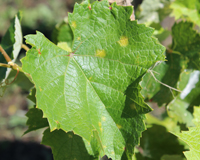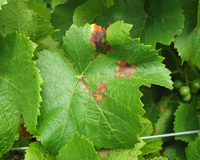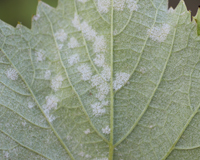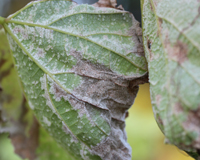Downy Mildew of Grape Disease Prediction Model
Introduction to Downy Mildew
Downy Mildew of grape is an important problem of grape in the Midwest, especially during years with heavy rainfall. Plasmopra viticola favors wet rainy conditions.
Initial infections are caused during sporulation from overwintering fungi. If weather is conducive for disease expansion, lesions develop on young leaves and shoots. Secondary spores develop as long as conditions are favorable. Disease development can enter a latent or resting phase during dry weather, and then become reinvigorated when rainy weather returns.
Leaf infection
Young infected leaves develop yellowish-green lesions on upper surfaces (Figure 1). Eventually, lesions expand and turn brown, nectrotic, or mottled (Figure 2). Defoliation may also occur. Mature leaves are also susceptible to infection. Mosaic patterns of small, angular, yellow-to-red spots on upper surfaces form along veins. In extremely wet conditions, white downy growth may be visible on undersides of leaves (Figure 3 & 4).
Fruit infection
Infected fruit develop turn light brown to purple, shrivel, and them fall from the vine. White downy or cottony fungal growth is often abundant on infected berries during wet or humid weather. Berries that are infected later in the season turn dull green to reddish purple and remain firm. Fruit become resistant to downy mildew 3 to 4 weeks after bloom, but cluster stems (rachis) remain susceptible throughout the season. Infected stems, rachises, or petioles can result in premature fruit drop.
More information on downy mildew of grape can be found in publication PPFS-FR-S-13.
Spray recommendations for commercial growers
ID232
and homeowners
ID-21
are also available online.




Figure 1. Initial downy mildew leaf lesions are yellowish-green.
Figure 2. Later, leaf lesions expand and turn brown, necrotic, or mottled.
Figures 3 & 4. White downy growth may be visible on undersides of leaves
Notes
Risk for downy mildew is highest during periods of heavy rain. Leaves are susceptible throughout the season, while fruit become resistant to infection 3 to 4 weeks after bloom.
Prediction model is based on leaf wetness duration and average temperature during wetness events.
Instructions
• Select county from drop-down menu using arrows.
• Select today’s date to determine current risk for downy mildew. Other dates may be entered if assessment of past risk is warranted.
• Determine vineyard history.
• Click 'submit choices'
These data are based on the 24 hour period 7PM to 7PM.
Data should NOT BE USED FOR LEGAL PURPOSES.